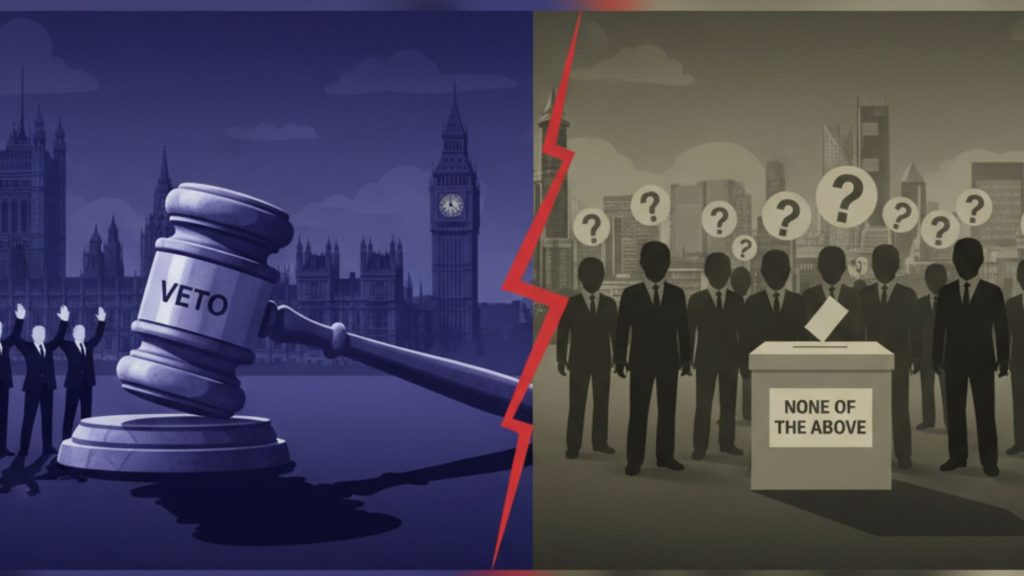VETO vs NOTA (None of the Above) in the UK: What’s the Actual Difference?

Public trust in UK politics is at an alarming low. A survey found that only 17% of registered voters believe political parties work in their best interest. Disillusionment with the system is pushing voters to consider reforms that would give them more power at the ballot box. Two ideas often raised are NOTA (None of the Above) and the VETO option. At first glance, they may look similar. Both allow voters to say “no” to the candidates on offer. But here’s the crucial difference: NOTA is often seen as symbolic, while the VETO option is actionable.
Let’s unpack why the VETO option in UK elections is fundamentally different from NOTA, how each works, and why adding a VETO to the ballot could be the safeguard that restores genuine voter control.
Understanding NOTA (None of the Above) in UK Elections
NOTA, short for None of the Above, gives voters the ability to reject all candidates listed on the ballot. The purpose is simple: if you don’t feel represented by anyone, you can express your dissatisfaction by selecting NOTA.
In countries where it exists, NOTA is treated as a protest vote. It sends a message of discontent, but does not change who wins the election. Even if NOTA receives more votes than any candidate, the candidate with the next-highest votes still takes office.
At present, the UK does not offer NOTA on its ballot. Campaigners argue it would allow citizens to record their dissatisfaction without abstaining from the electoral process entirely. But even if implemented, NOTA in the UK would not be binding. It would not force new elections or require better candidates.
This is its biggest weakness. Imagine millions of voters choosing NOTA, making it the most popular “candidate.” The result would still stand, the same MPs would enter parliament, and the underlying frustrations of voters would remain ignored.
In short, NOTA highlights a problem but provides no solution.
What Is the VETO Option for UK Elections?
Now let’s look at the VETO option, a proposal that goes beyond symbolism. The VETO option for UK elections would give voters the power to reject an entire election outcome if the majority believes it lacks legitimacy.
Here’s how it would work:
- If more than 50% of voters select the VETO option, the election is invalidated.
- Political parties will return with reformed platforms.
- New candidates are not required unless that is what is dictated by VETO voters.
- A fresh election is held, ensuring voters are not forced to choose between equally unacceptable options.
This distinction matters. Unlike NOTA, which is a passive protest, the VETO is an active democratic safeguard. It prevents elections from drifting into outcomes that are legal but lack public consent.
It can be summarised in:
“It’s our duty as voters to reject elections that cannot deliver us good representation.”
VETO vs NOTA: The Key Differences
Let’s break down the differences clearly:
- Purpose
- NOTA: A symbolic way to say “none of these candidates represent me.”
- VETO: A binding mechanism to reject elections that fail to offer legitimate representation.
- Impact
- NOTA: No change to results. The least-unpopular candidate still wins.
- VETO: Triggers a rerun with new candidates or platforms.
- Actionability
- NOTA: Expresses frustration but leads nowhere.
- VETO: Directly alters the election outcome if enough voters agree.
- Accountability
- NOTA: Politicians may take note, but they’re not compelled to act.
- VETO: Politicians must secure broad legitimacy or risk rejection.
- Voter Engagement
- NOTA: May encourage protest voting but risks reinforcing apathy.
- VETO: Empowers voters to participate, knowing their rejection carries legal weight.
In other words, NOTA is a protest. VETO is a solution.
Why the UK Needs a VETO Option on the Ballot?
The UK’s electoral system is struggling. Safe seats, low turnout, and declining trust are symptoms of a deeper problem: voters feel trapped between poor choices.
The VETO option for UK elections offers a way out. It would:
- Rebuild trust in democracy: When voters know they can reject an unfair election, confidence in the system rises.
- Hold candidates accountable: MPs would have to genuinely represent constituents, not just party elites.
- Force better options: Political parties would no longer rely on “lesser evil” strategies. They would need to offer real, popular alternatives.
- Strengthen legitimacy: Governments formed after surviving a VETO test would carry undeniable democratic weight.
As we can put it:
“The poor design of our electoral system leads to poor candidates winning elections. A VETO option fixes it.”
A Path Toward True Voter Control in UK Elections
The debate isn’t just about technical reform. It’s about the principle of consent of the majority. Real democracy requires more than the right to choose between two unappealing options. It requires the right to withhold consent when no option is acceptable.
Adding a VETO election campaign in the UK could transform voter engagement:
- Citizens would know their rejection has consequences.
- Political parties would have to listen more closely to grassroots concerns.
- The cycle of voter apathy could be reversed by giving people real leverage.
It’s not about destabilising elections. It’s about making them legitimate.
Conclusion: The Real Change the UK Needs
The VETO option is all about making democracy real again. Unlike NOTA, which is a symbolic protest, VETO is a binding safeguard. It empowers voters to reject elections that don’t represent them and demand better options.
Without a VETO campaign, elections risk becoming legal but illegitimate. With it, the UK could rebuild trust, strengthen accountability, and ensure that every vote truly counts.
Now is the time to move beyond symbolic gestures and embrace meaningful change.
Join the movement. Sign the petition. Take control of your elections.

[…] when we compare VETO vs NOTA in the UK, Veto has a prominent edge. Unlike NOTA, the veto option can actually make a difference in the […]